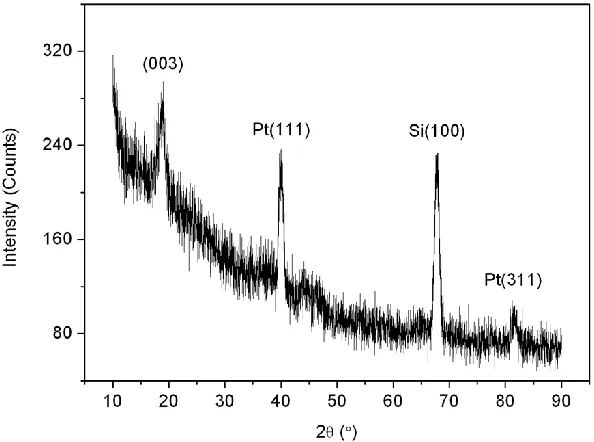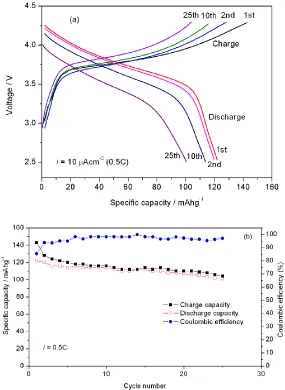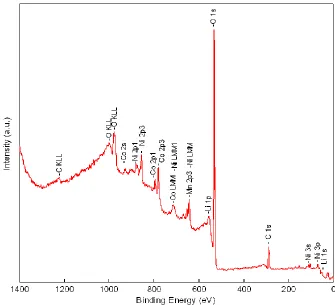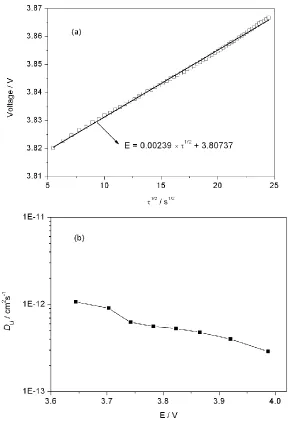Int. J. Electrochem. Sci., 8 (2013) 1770 - 1777
International Journal of
ELECTROCHEMICAL
SCIENCE
www.electrochemsci.org
Electrochemical Properties of LiNi
0.50Co
0.25Mn
0.25O
2Thin Film
Cathodes Prepared by Pulsed Laser Deposition
Jianqiu Deng1, *, C.Y. Chung2, Xiaodong Han3, Yan Zhong1, Zhongmin Wang1, Huaiying Zhou1
1
School of Material Science and Engineering, Guilin University of Electronic Technology, Guilin 541004, China
2
Department of Physics & Materials Science, City University of Hong Kong, Tat Chee Avenue, Kowloon, Hong Kong SAR, China
3
Institute of Microstructure and Property of Advanced Materials, Beijing University of Technology, Beijing 100022, China
*
E-mail: jqdeng@guet.edu.cn
Received: 26 December 2012 / Accepted: 19 January 2013 / Published: 1 February 2013
LiNi0.50Co0.25Mn0.25O2 thin film cathodes are successfully prepared by pulsed laser deposition technique with post-annealing treatment. The microstructure of the thin films is characterized by X-ray diffraction, environmental scanning electron microscopy, X-ray photoelectron spectroscopy and atomic force microscopy. The electrochemical performance of the thin film electrodes is evaluated by cyclic voltammetry and charge-discharge cycling tests. LiNi0.50Co0.25Mn0.25O2 thin film electrodes deliver good electrochemical performance. The initial discharge capacity of the thin film electrodes is 122 mAhg-1 measured at a rate of 0.5C in the voltage range of 2.8–4.3 V. The coulombic efficiency is beyond 94% in addition to the first charge-discharge cycle. The chemical diffusion coefficients of lithium ions in the thin film electrodes are in the range of 10-11 – 10-13 cm2s-1 determined by galvanostatic intermittent titration technique (GITT) method.
Keywords: LiNi0.50Co0.25Mn0.25O2, Thin film electrode, Lithium ion batteries, Electrochemical performance, Pulsed laser deposition
1. INTRODUCTION
family, due to its high initial discharge capacity (174 mAhg−1) within the potential of 3–4.3 V (vs. Li+/Li) [7–8]. The low content of Co is also beneficial to reduce the cost and toxicity. Researchers still focus on the study of LiNi0.50Co0.25Mn0.25O2 powders [7–9]. Nevertheless, to the best of our knowledge, there are no reports on LiNi0.50Co0.25Mn0.25O2 thin film electrodes.
Micro lithium ion batteries, consisting of thin film electrodes and electrolytes have been of great interest due to their potential applications as power sources for microelectronic devices [10]. As the development of microelectronic devices, the need to develop the micro batteries with high power and high energy density increases. Thin film cathodes of conventional active materials, such as LiCoO2, have been reported to use well in thin film batteries [11–13]. However, the thin film cathodes do not meet the requirement. The thin film electrodes of the LiNi1-x-yMnxCoyO2 oxides family have attracted more and more interest because of their excellent electrochemical performance. The LiNi0.33Mn0.33Co0.33O2 thin film electrodes [14, 15] have been reported that they presented a high discharge capacity of more than 120 mAhg-1. Kim et al. recently have reported a LiNi0.4Co0.3Mn0.3O2 thin film electrode prepared by an aerosol deposition method. The LiNi0.4Co0.3Mn0.3O2 thin film electrode delivered an initial discharge capacity of 44.6 μAh cm-2 [16]. In the present work, LiNi0.50Co0.25Mn0.25O2 thin films are successfully prepared by pulsed laser deposition (PLD) technique. The electrochemical performance of LiNi0.50Co0.25Mn0.25O2 thin film electrodes is investigated in details. Furthermore, the lithium ion diffusion coefficients of thin film electrodes are also discussed.
2. EXPERIMENTAL PART
The target was prepared by using LiNi0.50Co0.25Mn0.25O2 powders with 5 wt% excess Li2O to compensate for Li loss during the deposition and heat treatment processes of thin films. LiNi0.50Co0.25Mn0.25O2 thin films were deposited on Pt/Ti/SiO2/Si substrates at ambient temperature in an O2 atmosphere of 50 mTorr for 60 min by PLD technique using a KrF excimer laser (300 mJ, 10 Hz). The thicknesses of Pt current collector layer and Ti buffer layer were 150 and 100 nm, respectively. The as-prepared thin films were then annealed at 450 ºC for 3 h with a constant heating rate of 2 ºCmin-1 in air to improve crystallization. The microstructure of LiNi0.50Co0.25Mn0.25O2 thin films was characterized by X-ray diffraction (XRD), X-ray photoelectron spectroscopy (XPS), environmental scanning electron microscopy (ESEM) and atomic force microscopy (AFM).
A two-electrode cell test equipment with lithium metal foil as the counter electrode was used in the electrochemical measurements. Constant current charge/discharge measurements were conducted using an Arbin (BT-2000) battery testing system. Cyclic voltammetry (CV) measurements were carried out using a Zaher Elektrik IM6 electrochemical workstation between 2.8 and 4.3 V versus Li/Li+ with a scan rate of 1 mVs-1. Galvanostatic intermittent titration technique (GITT) measurements were performed after 5 charge–discharge cycles. The cell was charged at a current density of 10 μAcm -2
3. RESULTS AND DISCUSSION
The X-ray diffraction pattern of the LiNi0.50Co0.25Mn0.25O2 thin film annealed at 450 ºC is shown in Fig. 1. The pattern displays a dominant peak at about 18.7º, indicating a (003) axis preferred growth of the thin film. The slightly intensive dominant peak suggests that the annealed thin film possesses a partially amorphous structure.
[image:3.596.146.443.235.456.2]The ESEM images of the annealed LiNi0.50Co0.25Mn0.25O2 thin film are shown in Fig. 2. The surface of the annealed thin film is slightly smooth with an average grain size of about 50 nm. The thin film exhibits the columnar structure observed from the cross-section ESEM image (Fig. 2b). The thickness of the thin film is estimated to be about 280 nm.
Figure 1. XRD pattern of LiNi0.50Co0.25Mn0.25O2 thin film.
[image:3.596.115.485.514.685.2]
[image:4.596.167.437.181.302.2]
The typical three-dimensional AFM image of the surface topography of the LiNi0.50Co0.25Mn0.25O2 thin film is shown in Fig. 3. Uniform microstructure and grain size distribution can be observed in LiNi0.50Co0.25Mn0.25O2 thin film. In order to study surface roughness, RMS (Root Mean Square) average roughness of the thin film was measured. RMS roughness determined from randomly selected regions is 18.5 nm, indicating that the obtained thin film has a relatively regular topography.
Figure 3. AFM image of the surface topography of LiNi0.50Co0.25Mn0.25O2 thin film.
Cycle voltammetry measurements were performed in the voltage range 2.8 – 4.3 V at a scan rate of 1 mVs-1. The cyclic voltammograms of the LiNi0.50Co0.25Mn0.25O2 thin film electrodes for the first three cycles are shown in Fig. 4. The curves exhibit a couple of well-defined anodic and cathodic peaks located at about 3.8 V and 3.5 V. This is a typical characteristic attributed to the deintercalation/intercalation process of Li+ ions in LiNi0.50Co0.25Mn0.25O2 cathode material [9]. It can be seen that the cathodic and anodic peaks exhibit a tiny shift during the second and third cycles, suggesting better cycle stability of the film electrode after the first cycle.
[image:4.596.148.440.499.722.2]
Fig. 5 shows the charge/discharge curves and the cycle performance of the LiNi0.50Co0.25Mn0.25O2 thin film electrodes. The constant current charge/discharge tests of the Li/LiNi0.50Co0.25Mn0.25O2 cell were carried out at a constant current density of 10 μAcm-2 (0.5C rate, 1C = 160 mAg-1) in the voltage range of 2.8 – 4.3 V. The initial charge and discharge specific capacities are 143 and 122 mAhg−1, respectively. The specific capacities were calculated assuming a density of 4.81 gcm-3. The discharge specific capacity is comparable to that of the LiNi0.33Co0.33Mn0.33O2 film electrodes [14]. The initial discharge specific capacity is about 130 mAhg-1 measured between 2.5 and 4.5 V at a current density of 7.8 μAcm-2
(0.24C rate). The coulombic efficiency (Fig. 5b) is beyond 94% in addition to the first charge-discharge cycle. This reveals good reversibility of lithium intercalation/deintercalation reactions in the thin film electrodes. The LiNi0.50Co0.25Mn0.25O2 thin film electrodes deliver a relatively good cycle performance. The discharge capacity retention is 83% after 25cycles.
[image:5.596.155.440.292.682.2][image:6.596.132.467.295.600.2]
However, the capacities are lower than the LiNi0.50Co0.25Mn0.25O2 composite electrode [7, 8]. The low capacities can be ascribed to the following reasons. The thin films are free of conducting agent, and the active area for electrochemical reactions is much smaller than that of the composite electrode in the liquid electrolyte. The partially amorphous structure of the LiNi0.50Co0.25Mn0.25O2 thin film electrodes is also an important factor resulting in their low capacities. In addition, Li deficiency in thin films may be one of reasons resulting in low capacities. In order to confirm the lithium deficiency of thin film electrodes, XPS analysis was used. Prior to collecting the XPS data, the surface (about 40 nm thickness) of LiNi0.50Co0.25Mn0.25O2 thin films was etched by ion beam sputtering to remove any surface contaminations. The molar ratio of Ni/Co/Mn is near 2:1:1 obtained from XPS analysis (see Fig.6). The molar composition of lithium in the thin films is 21.76%, indicating the loss of part of lithium during the deposition and heat treatment processes for the thin films.
Figure 6. XPS spectrum of LiNi0.50Co0.25Mn0.25O2 thin films.
2 s 2 Li
τ 4
( ) π
E
D L
E
(
2
Li L
D
) (1)
where DLi (cm2s-1) represents the Li-ion diffusion coefficient. L (cm) is the thickness of the thin film electrodes. ΔEs and ΔEτ are the change of equilibrium voltage for a single titration and the total change of cell voltage (after subtracting the IR drop).
[image:7.596.154.444.264.685.2]The Li-ion diffusion coefficients, DLi, calculated using Eq. 1 as a function of the cell voltage is shown in Fig. 7b. The values of DLi in LiNi0.50Co0.25Mn0.25O2 thin film electrodes are in the range of 10-11 – 10-13 cm2s-1. The DLi values in this study are in agreement with results obtained in LiCoO2 [18] and LiNi0.5Mn0.5O2 [19] thin film electrodes.
4. CONCLUSIONS
Layered LiNi0.50Co0.25Mn0.25O2 thin film electrodes have been successfully prepared by pulsed laser deposition technique. The microstructure and electrochemical properties of thin film electrodes have been investigated. LiNi0.50Co0.25Mn0.25O2 thin film electrodes exhibit good electrochemical performance. The first discharge specific capacity is 122 mAhg-1 tested at a rate of 0.5C in the voltage range of 2.8 – 4.3 V. The coulombic efficiency is beyond 94% except the first charge-discharge cycle, and the capacity retention ratio is 83% after 25 charge-discharge cycles. The Li-ion diffusion coefficients in LiNi0.50Co0.25Mn0.25O2 thin film electrodes are in the range of 10-11 – 10-13 cm2s-1 obtained by GITT method.
ACKNOWLEDGMENT
This research is jointly supported by the program of Guangxi Natural Science Foundation (Project No. 2012GXNSFBA053154 and 2012GXNSFGA060002) and the Hong Kong Research Grant Council (RGC) General Research Funds (GRF, No. 9041528).
References
1. W. Tang, L.L. Liu, S. Tian, L. Li, Y.B. Yue, Y. P. Wu, S.Y. Guan and K. Zhu, Electrochem. Commun., 12 (2010) 1524.
2. J.W Fergus, J. Power Sources, 195 (2010) 939.
3. J. Liu, J. Wang, Y. Xia, X. Zhou, Y. Saixi and Z. Liu, Mater. Res. Bull., 47 (2012) 807.
4. S.K. Martha, H. Sclar, Z.S. Framowitz, D. Kovacheva, N. Saliyski, Y. Gofer, P. Sharon, E. Golik, B. Markovsky and D. Aurbach, J. Power Sources, 189 (2009)248.
5. J. Jiang, K.W. Eberman, L.J. Krause and J.R. Dahn, J. Electrochem. Soc., 152 (2005)A566. 6. J. Choi and A. Manthiram, J. Power Sources, 162 (2006) 667.
7. P.Y. Liao, J.G. Duh and S.R. Sheen, J. Electrochem. Soc., 152 (2005) A1695. 8. R. Guo, P. Shi, X. Cheng and L. Sun, Electrochim. Acta, 54 (2009) 5796.
9. C.S. Dai, H. Ge, D.L. Wang and F.P. Wang, Chin. J. Inorg. Chem., 23 (2007) 432.
10. J.B. Bates, N.J. Dudney, B. Neudecker, A. Ueda and C.D. Evans, Solid State Ionics, 135 (2000) 33 11. N. J. Dudney and Y.-I. Jang, J. Power Sources, 119–121 (2003) 300.
12. C.V. Ramana, K. Zaghib and C.M. Julien, Appl. Phy. Lett., 90 (2007) 021916. 13. M. Takahashi, M. Hayashi and T. Shodai, J. Power Sources, 189 (2009) 191.
14. J. Xie, N. Imanishi, T. Zhang, A. Hirano, Y. Takeda and O. Yamamoto, J. Power Sources, 195 (2010) 5780.
15. J. Deng, L. Xi, L. Wang, Z. Wang, C.Y. Chung, X. Han, H. Zhou, J. Power Sources, 217 (2012) 491.
16. I. Kim, T.-H. Nam, K.-W. Kim, J.-H. Ahn, D.-S. Park, C. Ahn, B. S. Chun, G. Wang and H.-J. Ahn, Nanoscale Res. Lett., 7 (2012) 64.
17. Y.-S. He, Z.-F. Ma, X.-Z. Liao and Y. Jiang, J. Power Sources, 163 (2007) 1053. 18. C.L. Liao, Y.H. Lee and K.Z. Fung, J. Alloys Compd., 436 (2007) 303.




